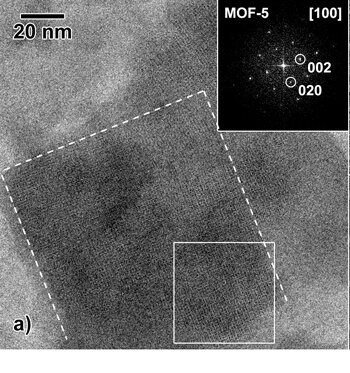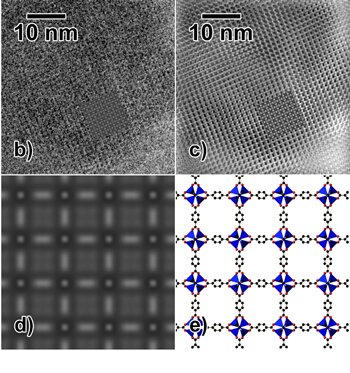Soft matter and sensitive materials
Polymers, porous materials and hybrid combinations of soft matter with inorganic components play an increasingly important role in the field of nanoscience. These “soft” materials however, require completely different imaging conditions in comparison to inorganic materials. Using TEM, “hard” matter is studied using accelerating voltages of typically 200-300kV, yielding structural information at an atomic scale. For soft matter on the other hand, radiation damage and lack of contrast has a tremendous effect on the resolution that can be obtained.
At EMAT, it is our goal to investigate soft and sensitive materials with maximized contrast and a minimum of radiation damage. We therefore exploit the use of modern TEM techniques such as aberration corrected TEM and HAADF-STEM. In many investigations, sensitive materials are investigated at low acceleration voltage. In principle, this leads to a reduction of the resolution, but aberration corrected TEM enables us to reach atomic resolution even at voltages as low as 60-80kV. Both the Qu-Ant-EM and the X-Ant-EM microscopes can be operated at these low voltages. Furthermore a novel beam-blanking system was recently implemented in our microscopes. Using this system, sensitive structures do not need to be exposed to the electron beam any longer than the exposure time, meaning the most sensitive of materials can be imaged. An example of high resolution imaging of a sensitive, porous material MOF-5 is given in Figura a).
We also aim to develop new techniques such as annular dark field TEM, a technique in which an annular objective aperture is used. An illustration of the increase in contrast for ADF-TEM in comparison to BF-TEM is presented in the second figure on the right.
In many cases, it is required to investigate soft materials in 3D because their structure is often of an aperiodic nature. Electron tomography is the ideal technique to perform 3D studies, but for such studies, a large number of images of the same area of interest needs to be recorded and the problem of beam damage is even more important. We therefore investigate the use of advanced 3D reconstruction algorithms that enable one to obtain 3D reconstructions based on a limited number of 2D images.
It must be noted that an environmental SEM was also recently installed at EMAT. This instrument enables one to investigate soft materials without the need for chemical fixation and dehydration.


